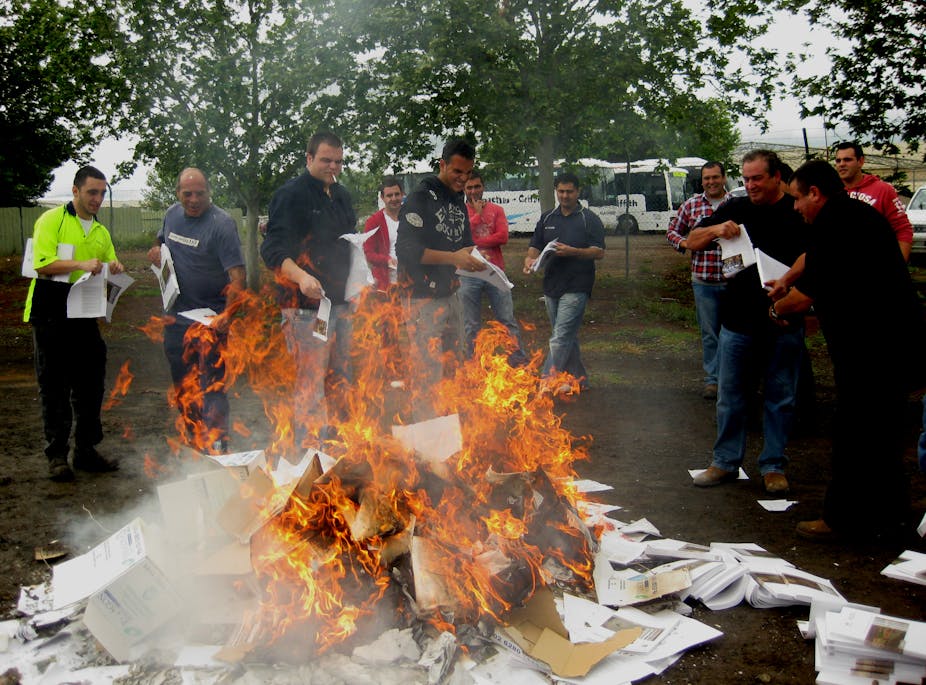Reports of the death of the Murray Darling Basin food bowl are grossly exaggerated, to borrow a phrase from Mark Twain.
Farmers have been up in arms about plans to give more water to the environment, but this new approach could actually be good news for irrigators.
Clearly the Murray Darling Basin is too important a resource to allow to wither.
Stretching across four states and with a territory encompassing less than 7% of the nation’s stream flow, it produces approximately 40% of our food, has a unique ecology and supports a host of resident communities.
In fact, the current controversial development of a basin plan to implement the 2007 Water Act has the potential to transform the area into a paragon of responsible and productive water management.
The environment comes first
The worst drought in the recorded history of the basin led to the development of the Water Act.
This drought exposed the frailties of the current system and let us see the impacts of future climate change on the basin.
For the first time, reform has placed the allocation of water to the sustainability of the environment above the needs of agriculture.
The likely impacts of climate change are also considered for the first time in the sustainable diversion limits for individual catchments.
This would result in a 27-37% reduction in the water withdrawn from watercourses in the basin for agriculture.
It’s this part of the plan that’s causing so much controversy.
Helping farmers means getting it right
Does taking water allocations away from farmers mean we’ll lose out financially? Or can we use the allocated water more efficiently?
This is certainly doable, but it will require a whole-of-system approach.
Water delivery systems are being modernised. But we need to investment more to modernise irrigation systems on farms.
We will need a world-leading water trading system that allows water to move seasonally to areas of greater demand to generate higher value.
And we will need to manage the system across state boundaries.
It will have to be flexible enough to respond to the droughts and floods that characterise our climate. We can expect more extreme weather in future and the system needs to plan for this.
There are opportunities to use water for both the environment and agriculture. But we will have to manage across both areas if this is to work.
The greater sophistication inherent in this approach will require more skill from farmers and water managers to operate it is the most efficient way.
Why water needs the NBN
But we can’t forget the people. Information is not much good unless it gets out to the communities and managers who need it.
Some of Australia’s irrigation farmers are among the best at using water productively and efficiently.
But many farmers and farming communities have not learned these management techniques or become familiar with accessible modern technology.
This is also the case for environmental managers who haven’t yet learned how to manage water.
Indeed, the science of environmental water management is not well developed due to years of underinvestment.
The communications technology and services that the national broadband network will bring to regional Australia will be critical to the successful implementation of the basin plan.
The NBN will also be a great way to get skills out to the people who will need them.
Valuable lessons from rice and cotton
For any of this to work, governments must promote more efficient and productive uses of water.
There are already good examples of this. Take the much-maligned rice and cotton industries.
In the most recent drought, rice production in Australia decreased from 1,750,000 tonnes in 2001 to 20,000 tonnes in 2008.
This dramatic reduction wasn’t just because there was so little water available.
It was also due to rice growers trading whatever water they had to horticultural producers in South Australia. They could afford to pay far more than the rice growers could make growing rice.
The cotton industry which operates in north-west New South Wales and Queensland generates more wealth per unit of water than any broadacre irrigation industry.
It makes more than dairy, rice or other cereals such as maize or wheat.
Optimising water use efficiency is about growing crops that are climatically adapted. The Australian dairy and cotton industries in their climatic niches are among the most efficient producers in the world.
To sustain future generations the management of major food bowls such as the MDB including their natural resources must be sustainable .
To do this we will need to apply the best of our science, economics and social skills.
We are not alone in this endeavour because as population pressures increase there will be extreme pressure on natural resources globally.
Our technological and economic skills can become just as valuable as the food we currently export.

